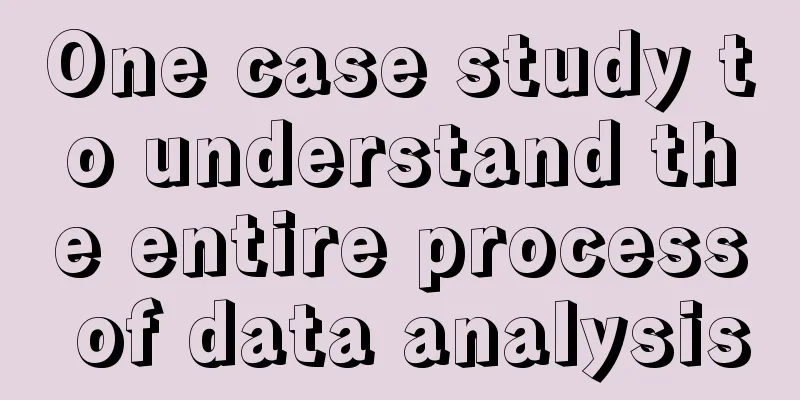[Special Topic on Strategic User Research] The End of User Research is Strategic User Research
![[Special Topic on Strategic User Research] The End of User Research is Strategic User Research](/upload/images/67e6f606cab2b.webp)
1. Where does strategic user research come from?We all know that strategic consulting and user research are two independent professions, so what is strategic user research? When and why did it appear in everyone’s vision? Many years ago, as Party A began to build its own user research team, user researchers have always had "value" anxiety. The root cause is that the user research team provides more of a supporting value, but does not rise to the level of segment value and even the ultimate strategic value. 1. Supporting valueWithin the enterprise, user researchers mainly serve as project undertakers, taking on user research needs from the business side. The characteristic of supporting value is that the responsibility is small, and accordingly the presence and importance in the enterprise are relatively small. 2. Linked valueWithin the enterprise, user research has become a special part of the business process. This segmentation has been clearly defined and enforced through process systems. The value of segmentation highlights the indispensability of user research, while also emphasizing the design of corresponding evaluation indicators to quantitatively evaluate one's work. 3. Strategic valueBased on user research, it can help companies make overall choices and actions. Strategic value is relatively the highest level of value of user research. The realization of this value requires top-down driving force and a user-centric culture within the company. Soon, based on this understanding, large companies began to change their organizational structure. The most typical example was to migrate the user research team under the original UED to the Strategy Department/Marketing and User Insight Department, and combine it with the two major functional lines of industry/market analysis and big data to jointly assist corporate strategy/operational decisions rather than just designer/product experience decisions. This organizational change has achieved remarkable results. The most typical example is the dissolution of Tencent's CDC (Customer Research & User Experience Design Center) (according to the explanation, the logic behind it is that the CDC, a design support department that is based on the middle platform, can no longer meet the company's development needs, and the team needs to be disbanded and reorganized to empower the business. In my opinion, this logic is actually not valid). Tencent's MUR (Market & User Research) still exists and continues to grow and develop. Soon after, the practical experience of this organizational structure was replicated and spread to more small and medium-sized factories, and more and more user research teams were placed under the Strategy Department/Marketing and User Insight Department. Different from the language system of supporting value, segmented value and strategic value of user research, Judd Antin from overseas wrote an article titled "UX Research Reckoning is Here" in 2023, which caused a sensation. He used micro, meso and macro to describe user research practices and their value output. There are three types of work that user researchers need to do:
The biggest reason user research faces this kind of judgment is that we do too many mid-range studies. Mid-range studies are sexy for researchers, but only add marginal value to actual product and design work. They largely lead to the worst possible perceptions and ideas about user research. So many mid-range studies don’t bring enough business value:
Even when researchers communicate their findings clearly, mid-range findings tend to be descriptive in nature and difficult to translate into concrete recommendations. They are therefore easily cherry-picked or ignored, triggering hindsight bias: “The stereotype that researchers worked for months only to tell us what we already knew.” All of these weaken the so-called commercial value of the research. Next, Judd Antin suggested refocusing 90% of efforts on micro and macro research. Regarding macro research, he said: At the same time, we need to do better at macro research. “Strategic” is often a buzzword researchers use on LinkedIn when they want to sound more advanced. In this case, it has a specific meaning: Strategic research helps companies decide on long-term goals, priorities, and the methods to achieve them.
It can be seen that overseas user research practitioners represented by Judd Antin are also aware of the close relationship between user research and strategy. Peron's overseas user research team translated this article and introduced it to China, completing another piece of the strategic user research puzzle. 2. How to correctly understand strategic user research?Usually the research practices conducted by user researchers are relatively complex, involving various project types. We need to have a criterion for judging which ones are strategic user research and which ones are not. To understand and distinguish strategic user research, in my opinion, there are three key points to grasp: 1. Who do we provide services for?Strategic user research must first serve the management decision-making level of the enterprise, rather than the front-line business. This is the most fundamental criterion for judgment. There may be overlaps, for example, the needs of the front-line business come from the management decision-making level. In most cases, the management decision-makers of an enterprise must be concerned about the business strategy/general direction of the enterprise, and will not pay much attention to micro and operational details. Their concerns and needs determine the value of user research to the greatest extent. 2. Research objectives/propositionsAs Judd Antin says, strategic user research helps companies determine long-term goals, priorities, and methods to achieve them, while non-strategic user research is usually short-term and non-prioritized. What are the long-term priorities?
Here are some strategic user research topics our team has received (de-identified):
What are short-term, low-priority items?
3. Research methods/pathsAn enterprise's strategic decisions need to rely on a variety of information such as industry/market changes, competitor actions, and trends in user demand. In other words, the business propositions that strategic user research aims to solve cannot rely solely on user research. For example: The user activity and time spent on a certain content product APP are declining. How to break the deadlock? Ideas:
The first and second points are not user research. In fact, conducting strategic user research within an enterprise requires the capabilities and resources of three functional lines: strategy, big data, and user research. How to better practice strategic user research1. Conduct user research based on the three levels of strategyThe company's strategy can be divided into three levels: overall strategy, business strategy, and functional strategy (R&D, manufacturing, sales, marketing, etc.). The company's overall strategy is the highest level of corporate strategy and the highest action program for the top management of the company to guide and control all the company's behaviors. User research based on the overall strategy mainly focuses on the company's mission and vision, strategic positioning and strategic goals, and focuses on growth, multiple businesses and product portfolio management. Business strategy is also called business unit strategy or division strategy because it usually occurs at the level of business units (such as business groups, divisions, product lines or subsidiaries). User research based on business strategy mainly focuses on improving the competitive position of business products or services in a certain industry or specific market segment where the business unit is located. Functional strategies usually occur in functional areas such as production, marketing and R&D. They are mainly based on corporate strategy and business strategy to determine the short-term business objectives and operational strategies in each functional area. User research based on functional strategies mainly focuses on the efficiency of production and marketing systems, the quality and scope of user services, and the focus of R&D work. 2. Number One Position Demand Insight and Business Perspective ComplementRegardless of the level of corporate strategy, when combining it with user research, the most critical point is to understand the needs of management/number one. This is also the biggest challenge that distinguishes strategic user research from non-strategic user research. This is because many user researchers within an enterprise do not have the opportunity to communicate directly with managers/number one people, resulting in an inaccurate and insufficiently timely understanding of their needs. Secondly, strategic user research must understand the business. Not only must it understand, but it must also have a high level of understanding. Otherwise, how can it empower the business? It is impossible. However, due to the modern division of labor, user researchers focus on the field of user research. Few people are proficient in the business. Many people have worked in an industry for more than ten years and seem to understand a lot of things in the industry, but once you talk to the company's business manager, you will find that it is all just talk. Is there a solution? Yes. Peron: I once had the opportunity to conduct strategic user research in the strategy department of a large company. In my opinion, the team’s strategic user research practice was quite successful. The key lies in the adoption of the “1+1” model. The first "1" is a professional user research team. Although the team is small, almost all of them are project experts who are familiar with user research methods and proficient in data analysis and mining. This "1" can ensure that our data collection is reliable and our data presentation is accurate, but this is not enough. The second "1" is the strategic manager who is extremely knowledgeable about the business, can talk directly with the boss, and is very familiar with the needs of the number one person in the company. This "1" can ensure that our research direction is correct and our ultimate user insights are truly valuable. What is the specific process? First, the managers of the strategy department will input the business propositions that the number one person in the company is concerned about during the project launch phase, and the user research team will break down the business propositions and transform them into research propositions (research design). It should be noted that the needs of the number one person in the company may be constantly changing during this period, and the information input of the strategy department managers must be timely, and the research design also needs to be constantly adjusted. Secondly, after the research design is finalized, routine execution (questionnaire survey, user data collection) is carried out. The user research team then makes a preliminary interpretation and presentation of the collected data and reports to the strategic department managers. Finally, the strategy manager interprets the data from the perspective of the top boss and the business, helping the user research team to adjust the report structure and tell an attractive story. This step is the most critical. The strategy manager will have a lot of new information (from market changes, changes in the boss's needs and concerns) input, and will raise many key questions, all of which require the user research team to provide targeted additional data insights. 3. Capacity system constructionAccording to Judd Antin's theory, user research is a pyramid. The bottom layer/foundation is user research at the micro product design/interaction/functional experience level, which mainly focuses on collecting user feedback and improving a product function, interaction, etc.; the middle layer is meso population insight, which focuses on understanding a certain type of user and exploring their needs; the top layer is macro strategic user research to solve company-level business problems. These three levels have different requirements for people's knowledge system: the micro level needs to build its own knowledge system more around user research, user experience, product/design/interaction; the meso level needs to build its own knowledge system more around user research, psychology, sociology, statistics, etc.; the macro-strategic level has the highest requirements, and needs to build its own knowledge system more around user research, business/industry, and business operations. Author: Peron; Source public account: Peron User Research (ID: 330829) |
<<: Industry differences in data analysis positions
>>: How to plan a marketing campaign that combines “brand value and business value”?
Recommend
Video Account launches another “big move”, will Tencent’s “e-commerce dream” be one step closer?
WeChat Video Account's actions in the e-commer...
Which is the exchange rate for RMB settlement? Will the exchange rate change?
As the global economy becomes increasingly interco...
Video Account’s 1 billion “ambition”: where does the confidence come from?
When it was first launched in 2020, Video Account ...
The most difficult 618 in history, who makes money by selling goods on B station
The cost of acquiring traffic on e-commerce platfo...
Mixue Ice City turns "green", the Snow King has the traffic code
This article first introduces what happened recent...
A 10-square-meter shop has 14,000 shareholders
Now, "cloud shareholders" on the Interne...
eBay Germany launches trade-in program
eBay Germany has announced that it has partnered w...
In addition to ABtest, there are better testing methods!
Do you ever feel stressed when facing the business...
Will Shopee gain traffic if I keep uploading products? What should I pay attention to?
Some of my seller friends are opening a store on t...
How long does it take to list products after the Amazon store is launched? How many days do I have to wait?
Many people are also curious about how long it wil...
Is “Moutai+” Moutai’s panacea?
This article analyzes in detail the advantages and...
The last mile of the car industry’s mind: Video account
The last mile of the car circle's mind in this...
Does it take three months of turnover to open a Shopee store? How to run a store?
Shopee is a local e-commerce platform in Southeast...
Can an inactive Shopee store be restored? Detailed answer
Many people have opened stores on Shopee but have ...
Pinduoduo Temu's Compliance with Japan's Consumer Product Safety Law (PSC)
Pinduoduo Temu merchants please note that the Japa...









